Pityriasis (Tinea) Alba Homeopathy Treatment and Its Homeopathic Medicine
Tinea alba is a skin condition of unknown cause which usually affects children and young adults characterized by round or oval hypo-pigmented patches on face with very fine scales. It is a self-limiting disease and it is not contagious.
Causes of Tinea (Pityriasis) Alba
There is no known cause for Tinea alba.
Triggering factors:
- Humid climate
- Heat
- Detergent and soaps
- Stress
- Dry skin
- Deficiency of vitamins and calcium
- Worms and parasites
Symptoms of Tinea (Pityriasis) Alba

It mainly affects children and young adults characterized by round or oval hypo-pigmented patches (1-4cm) mostly on the face with very fine scales. Occasionally, it may be associated with mild itching.
Commonly affected parts:
- Cheeks
- Around the mouth
- Forehead
- Chin
- Chest and shoulders
Pityriasis Alba becomes worse in the summer season; it becomes more prominent as the skin tans in the surrounding area due to sun exposure.
Although the condition typically lasts six to twelve months or more without treatment, Pityriasis Alba usually resolves after puberty or by the time the child reaches adulthood.

Pityriasis alba treatment
Usually, treatment is not required as it gets settled down on its own. Patients are suggested to keep away from harsh sunlight. Also, swimming may be avoided to avoid prominent look of the spots on the face; as chlorine in pool water could lead to tanning. Primarily treatment consists of good skin care and applications of moisturizer. If there is redness or itching then steroid-based cream is prescribed.
Lesions become prominent in sun exposure, so to reduce the discrepancy sunscreen creams are recommended.
Pityriasis alba treatment in homeopathy
In resistant cases, some homeopathic medicines help recovery. Homeopathy is recommended if the disease does not self-recover in about three months.
Pityriasis alba homeopathic medicine
Tinea alba may not require any medicine, as it is self-limiting. However, it takes a long time to resolve spontaneously, some of the following medicines may be considered based on the individual symptoms:
Bacillinum:
Sourced over one hundred years ago from tubercular organisms, this medicine is a safe and effective bet for treating resistant cases of viral and fungus infections on the skin including Tinea alba, Tinea corporis, Tinea Versicolor, and the like. Infrequent doses are usually administered and one would expect results in six-week time.
Written & Approved by-
Dr. Rajesh Shah
M.D. (Hom.)